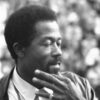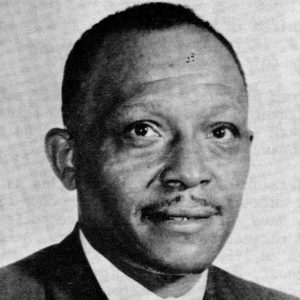calsfoundation@cals.org
National Black Political Convention (1974)
Little Rock (Pulaski County) hosted the second National Black Political Convention (NBPC) at Robinson Auditorium and Central High School on March 15–17, 1974. This followed the first convention, which was held in Gary, Indiana, in February 1972. The aim of both conventions was to seek a common agenda for Black advancement between a growing cohort of elected African American politicians and grassroots activists.
The theme of the Gary convention was “Unity without Uniformity,” but it was disunity that characterized the meeting. Black politicians played a prominent role, while Black nationalists seized control of the program agenda. The convention passed two resolutions, one condemning the use of busing to desegregate schools and the other demanding the dismantling of the state of Israel. The two resolutions were subsequently watered down to appease Black politicians who deemed them too radical.
Little Rock was chosen as the NBPC’s second venue in the hope that this location would allow the convention to focus more on the role of grassroots activists rather than Black politicians. First, the city was the site of a defeat for white supremacy during the 1957 desegregation of Central High School. Second, the desegregation provided a signal victory for grassroots activism, led by Daisy Bates, who was the state National Association for the Advancement of Colored People (NAACP) president, along with the members of the Little Rock Nine. Third, the desegregation victory was won in the absence of Dr. Martin Luther King Jr., an indication that the civil rights movement could triumph even without a prominent national Black leader.
When the second NBPC opened, the discord that had characterized the first convention continued. A number of prominent Black politicians failed to attend, including one of the three convention co-chairs, Representative Charles Diggs Jr. (Democrat, Michigan). Neither of the other two convention cochairs—Gary’s mayor Richard Hatcher, representing Black politicians, and poet Amiri Baraka, representing grassroots activists—could say why he was missing.
Hatcher finally called the convention to order on Friday, two hours behind schedule. Robinson Auditorium, with a capacity of 2,600, was less than half full. The credentials committee said that only 599 delegates and 215 observers had attended. The official number registered for the convention was 1,718, whereas there had been 8,000 people registered at the Gary convention. At a press conference afterward, Rep. John Conyers Jr. (Democrat, Michigan) said he was confident that at least “the grassroots of America” was well represented.
Baraka took charge of the main proceedings on Friday evening when he read aloud a report produced by the convention’s steering committee. The report concluded, “On every side, in every area of our lives, the American institutions in which we have placed our trust are unable to cope with the crisis they have created by their single-minded dedication to profits for some and white supremacy above all.”
Central High School was the main venue on the second day of the convention. A number of workshops were held in sixteen different classrooms. The showpiece event was a tribute to Daisy Bates, at which Basil Patterson, vice chair of the national Democratic Party, described Bates as the “rock of Little Rock” and presented her with a plaque. Ernest Green was the only one of the Little Rock Nine to attend the event. The Black principal of Central High, Edwin L. Hawkins, presented an award to the parents of the members of the Nine, noting the sacrifices they had made. Lois Pattillo, the mother of Melba Pattillo, collected the award on their behalf.
Jesse Jackson, president of People United to Save Humanity (PUSH), made an unannounced appearance at the event. Jackson had been one of the most prominent voices at the Gary convention, but he had not been invited to Little Rock in an effort to shift the focus away from national leaders. He told the media that he was in the city to preach the following morning at Mount Pleasant Baptist Church at 14th and Ringo Streets. Rep. Conyers suggested that Jackson’s preaching appointment may not have been “purely accidental” in coinciding with the convention.
The convention speeches that were delivered that evening at Robinson Auditorium by co-chairs Hatcher and Baraka further highlighted the gulf between Black politicians and grassroots activists. Hatcher criticized Black politicians for not playing a more active role in the convention and advocated forming a bold and united national Black political coalition for the future. By contrast, Baraka called for the “total overthrow of all forces that seek to define…African people,” and he went on to rail against capitalism, industrialism, and imperialism. Both Hatcher and Baraka received standing ovations for their very different messages.
Jesse Jackson once again cast a long shadow over the final day of the convention with his Sunday morning sermon at Mount Pleasant Baptist Church. An overflow crowd of almost 1,000 packed the church and its environs. Jackson encouraged African Americans to use their newfound political and purchasing power as leverage with white businesses to elicit more and better employment opportunities.
The final convention session at Robinson Auditorium that evening clearly lacked Jackson’s pulling power, as only 309 people attended. The convention’s central proposal, to form a national Black political party, was comprehensively voted down by a voice vote. Most delegates agreed that community organizing should be the top priority. In his closing speech, comedian Dick Gregory—who had been arrested in Pine Bluff (Jefferson County) for participating in civil rights demonstrations ten years earlier—tried to paper over the cracks at the convention. Gregory said that disagreements should not detract from the delegates’ shared passion for change, pointing out that such disagreements were a natural part of any democratic process.
Those who participated in the second NBPC had hoped that the convention would be a meeting place where they could find a way to bridge the disparate interests and agendas of Black politicians and grassroots activists. Yet instead of a coming-together, it proved to be a parting of the ways, as different leaders, organizations, and activists took increasingly divergent paths.
For additional information:
Chappell, David L. Waking from the Dream: The Struggle for Civil Rights in the Shadow of Martin Luther King, Jr. New York: Random House, 2014.
Cruse, Harold W. “The Little Rock National Black Political Convention.” Black World 23 (October 1974): 10–17.
Kirk, John A. “A Civil Rights Crossroads in Little Rock: The 1974 National Black Political Convention.” Arkansas Times, February 2020, pp. 79–81. Online at https://arktimes.com/history/2020/01/30/a-civil-rights-crossroads-in-little-rock (accessed July 28, 2022).
Moore, Leonard N. The Defeat of Black Power: Civil Rights and the National Black Political Convention of 1972. Baton Rouge: Louisiana State University Press, 2018.
Smith, Robert Charles. We Have No Leaders: African Americans in the Post–Civil Rights Era. Albany: State University of New York Press, 1996.
John A. Kirk
University of Arkansas at Little Rock
 Black Power Movement
Black Power Movement Civil Rights Movement (Twentieth Century)
Civil Rights Movement (Twentieth Century) Divergent Prosperity and the Arc of Reform, 1968–2022
Divergent Prosperity and the Arc of Reform, 1968–2022 Edwin L. Hawkins
Edwin L. Hawkins 




Comments
No comments on this entry yet.